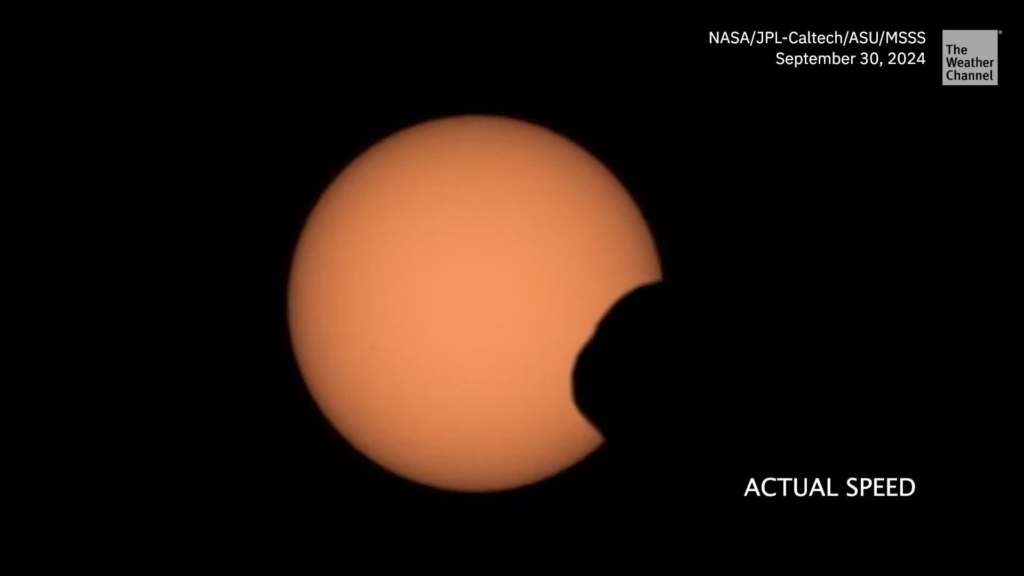NASA’s Perseverance rover recently captured a captivating celestial event on Mars that created an unusual visual effect – what NASA described as a “googly eye” eclipse. The moment, captured by the rover’s Mastcam-Z camera, occurred when Phobos, Mars’ larger moon, crossed directly between the Sun and the Martian surface, blocking out part of the Sun’s light.
This transit showcased Phobos as a “pupil” against the bright “iris” of the Sun, resulting in a distinctive, eye-like appearance that has intrigued astronomers and space enthusiasts alike. The video, posted by Perseverance’s official X (formerly Twitter) handle, captures a surreal moment that underscores the rover’s role in unveiling the Red Planet’s mysteries.
The “Googly Eye” Eclipse: A Rare Martian Moment
On its 1,285th Martian day (September 30, 2024), Perseverance witnessed a rare alignment where the potato-shaped Phobos created an eclipse by obscuring a large portion of the Sun. This alignment offered a striking visual experience, emphasizing the unique characteristics of Phobos and its relationship with Mars.
Although it was a partial eclipse, the event illustrated how Phobos, which orbits Mars three times daily, interacts dynamically with its host planet. Perseverance’s Mastcam-Z camera is designed precisely for such close observations, providing detailed imaging of Phobos as it passed across the Sun.
Read : NASA Satellite Captures Rare Sight of ‘Sea Smoke’ at Antarctica’s Pine Island Glacier
The “googly eye” analogy has resonated with viewers around the world, both for its scientific appeal and its visually intriguing nature. This is not the first time a Martian rover has captured such an event – NASA’s Curiosity rover recorded a similar Phobos transit in 2019, and Opportunity even managed to capture one in 2004.
However, the latest video by Perseverance brings a new level of clarity and charm, making the Martian skies seem oddly familiar to Earth observers.
The History and Future of Phobos: Mars’ Closest Moon
Discovered in 1877 by astronomer Asaph Hall, Phobos is named after the mythological son of Ares, the Greek counterpart of the Roman god Mars. The name “Phobos” translates to “fear,” while its sibling moon, Deimos, means “terror.”
At about 27 by 22 by 18 kilometers in size, Phobos is significantly larger than Deimos and orbits Mars at a closer distance. Because of its proximity, Phobos completes three orbits around Mars in a single Martian day, racing across the Martian sky at impressive speed.
Ever feel like someone's watching you?
— NASA's Perseverance Mars Rover (@NASAPersevere) October 30, 2024
That's how I felt when I observed this transit of the Martian moon Phobos! The pupil in this "googly eye" is the potato-shaped moon, and the iris is our Sun. Learn more: https://t.co/jUYoXY1jpK pic.twitter.com/7izVWOHEPH
Phobos’ relationship with Mars is, however, on a collision course. Orbiting just 6,000 kilometers above Mars’ surface, it is slowly spiraling inward at a rate of about 1.8 meters per century.
This gradual descent means that, in approximately 50 million years, Phobos will either crash into Mars or disintegrate into a ring system. Understanding Phobos’ orbital decay could give scientists insights into the evolution of natural satellites and the forces that shape their trajectories over time.
This event also serves as a reminder of how Mars differs from Earth in terms of its moons. Unlike our stable, singular Moon, Mars hosts two irregularly shaped moons that create dynamic solar eclipses unique to the Red Planet. The study of these eclipses aids researchers in better understanding the composition and behavior of Phobos and the potential for satellite interactions with planets.
Signs of Life? Discovering Organic Molecules on Mars
Perseverance’s discoveries have extended beyond eclipses and atmospheric phenomena to deeper questions about life on Mars. In July 2024, the rover stumbled upon a rock sample, nicknamed “Cheyava Falls,” containing organic molecules and structures that hinted at potential microbial life from billions of years ago.
This sample revealed chemical signatures that may have been created by ancient Martian microorganisms during a time when Jezero Crater, Perseverance’s exploration site, was believed to be filled with liquid water.

NASA described these findings as a promising step toward understanding Mars’ potential for life, both past and present. While organic molecules alone are not definitive proof of life, they are essential building blocks that increase the likelihood of microbial existence. These structures could have formed through non-biological processes, but the presence of water during that period increases the possibility of microbial activity.
As Perseverance continues its mission, it will investigate similar rock formations, collect samples, and analyze geologic contexts. The rover’s findings will serve as a guide for future Mars exploration missions, including sample-return missions that could allow scientists on Earth to examine Martian samples firsthand. With each discovery, Perseverance brings us closer to answering the age-old question of whether life ever existed on Mars.
let’s enjoy few years on earth with peace and happiness….✍🏼🙏

